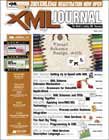Tutorials on Using XML for Content Publishing
This article appeared in Volume 2 Issue 5 of XML Journal magazine in 2001.
1 Orientation
XML. And XSLT, DTD, XPath, XSL-FO, XLink, XPointer, SAX, and DOM. To the uninitiated, all the talk about XML quickly dissolves into an alphabet soup of W3C recommendations, abbreviations, and acronyms. This column, with a minimum of technobabble and a good dose of hands-on work, aims to indoctrinate you into the world of XML and to teach you how to use it for web publishing. The folllowing tutorials aim to expand your knowledge of XML and, after the first couple of columns, expose you to a different member of the XML family of technologies or to one of its close relatives to learn how to combine these technologies to serve your own content and publishing objectives.

2 Tutorials
The tutorials in this series proceed as follows:
- An Introduction to XML
- Structuring Documents in XML
- Developing a Document Type Definition
- Attributes and Entities in DTDs
- An Introduction to XSL
- Using XSLT to Separate Content from Presentation
3 What Is XML?
All this talk about XML raises the question: What is it anyway? And what about the jumble of abbreviations that cloaks XML from the curious eyes of an HTML coder or content author? How do XSLT, DTD, XLink and all the rest fit into the XML equation?
Extensible Markup Language is, first and foremost, a metalanguage for
describing and structuring data with tags. “Metalanguage” means a
language for how to describe other languages. Like HTML, XML uses tags
(words bracketed by “<” and “>”), but
unlike HTML, XML has neither a predefined set of tags nor rules for how
to use them (though XML does have generic rules governing markup; for
instance, tags may not overlap). In XML, tags and the rules for them, or
grammar, are defined by the users themselves. XML programmers use tags
and their corresponding grammar to describe and structure data in a
simple text format like that of HTML (as opposed to a binary format).
Because users can define their own tags, XML, as its full name implies,
is also extensible, meaning that it is capable of being extended.
Articles on XML
Attributes and Entities in DTDs
Introduction to XSL: Using Stylesheets to Separate Content from Presentation
Switching Document Views with XML and Script
XML: A Metalanguage for Describing and Structuring Data
Using Data Structure Standards to Foster Efficiency and Opportunity
Principles of Separating Content from Presentation
Using XSL and CSS to Format XML Documents
DITA and DocBook: An Overview and Demonstration
XML Markup Strategies: Approaches for Structuring Documents
DocBook SEO: Tagging DocBook XML Documents for Search Engine Optimization
XC: A Minimalist, Structural DTD for XML Points Towards Markdown Documents
Review: Using XML to Separate Content from Prensentation | PDF